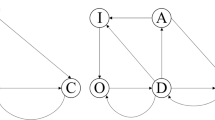Abstract
In enforcing the Civil Rights Acts of 1964 and 1991, it is often critical to determine whether a challenged procedure has systematic adverse impact. The use of statistical significance tests to make this determination has the perverse consequence that the size of an organization or an applicant pool has more impact on determining adverse impact than the extent to which procedures actually discriminate. That is, it is worse to be big than to be bad. We use Monte Carlo studies to illustrate this unforeseen consequence of current enforcement policies and note that a broader definition of adverse impact is clearly warranted.


Similar content being viewed by others
References
Brown v. Nucor Corp (2009) 576 F.3d 149.4th Cir.
Castenda v. Partida, 430 U.S. 482 (1977).
Cohen, J. (1988). Statistical power analysis for the behavioral sciences (2nd ed.). Hillsdale, NJ: Lawrence Erlbaum Associates.
Cohen, J. (1994). The earth is round (p < .05). American Psychologist, 49, 997–1003.
Equal Employment Opportunity Commission (2010). Charge statistics FY97 to FY210. http://www.eeoc.gov/eeoc/statistics/enforcement/charges.cfm.
Equal Employment Opportunity Commission, Civil Service Commission, Department of Labor, & Department of Justice. (1978). Uniform guidelines on employee selection procedures. Federal Register, 43(166), 38290–39315.
Hazelwood School District v. United States, 433 US 299, 308 (1977).
Jacobs, R., Deckert, P. J., & Silva, J. (2011). Adverse impact is far more complicated than the uniform guidelines indicate. Industrial and Organizational Psychology; Perspectives on Science and Practice, 4, 558–561.
Jeanneret, R. (2005). Professional and technical authorities and guidelines. In F. Landy (Ed.), Employment discrimination litigation: Behavioral, quantitative and legal perspectives (pp. 47–100). San Francisco: Jossey-Bass.
McDaniel, M. D., Kepes, S., & Banks, G. (2011). The Uniform Guidelines are a detriment to the field of personnel selection. Industrial and Organizational Psychology; Perspectives on Science and Practice, 4, 494–514.
Murphy, K., & Jacobs, R. (2012). Using effect size measures to reform the determination of adverse impact in equal employment litigation. Psychology, Public Policy and the Law.
Murphy, K., Myors, B., & Wolach, A. (2009). Statistical power analysis: A simple and general model for traditional and modern hypothesis tests (3rd ed.). Mahwah, NJ: Erlbaum.
Nielsen, L. B., Nelson, R. L., Lancaster, R., & Pedriana, N. (2008). Contesting workplace discrimination in court: Characteristics and outcomes of federal employment discrimination litigation 1987–2003. Retrieved from http://www.americanbarfoundation.org/uploads/cms/documents/nielsen_abf_edl_report_08_final.pdf).
Office of Federal Contract Compliance Manual. (2010). http://www.dol.gov/ofccp/regs/compliance/fccm/fccmanul.htm.
Roth, P. L., Bobko, P., & Switser, F. S. (2006). Modeling the behavior of the 4/5 rule for determining adverse impact: Reasons for caution. Journal of Applied Psychology, 91, 507–522.
Stagi v. National RR Passenger Corp., 391 Fed, Appx. 133 (3d Cir. Aug. 16, 2010).
Taylor, H. C., & Russell, J. T. (1939). The relationship of validity coefficients to the practical effectiveness of tests in selection. Journal of Applied Psychology, 23, 565–578.
Zedeck, S. (2010). Adverse impact: History and evolution. In J. L. Outtz (Ed.), Adverse Impact: Implications for Organizational Staffing and High Stakes Selection (pp. 3–28). New York: Routledge.
Author information
Authors and Affiliations
Corresponding author
Rights and permissions
About this article
Cite this article
Jacobs, R., Murphy, K. & Silva, J. Unintended Consequences of EEO Enforcement Policies: Being Big is Worse than Being Bad. J Bus Psychol 28, 467–471 (2013). https://doi.org/10.1007/s10869-012-9268-3
Published:
Issue Date:
DOI: https://doi.org/10.1007/s10869-012-9268-3




